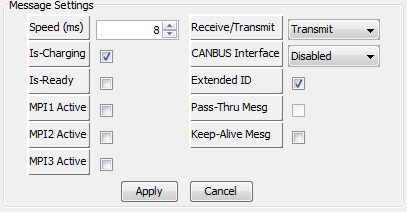

Message Speed: This is the speed (frequency) interval at which the message is either received or transmitted. It is in increments of 8ms.
Extended (CANBUS ID Mode): There are two different ID modes for a typical CANBUS interface. Extended mode allows for CANBUS message identifiers (IDs) of up to 29 bits in length (eg: 0x1 to 0x1FFFFF) whereas the standard mode allows up identifiers up to 11 bits in length (eg: 0x1 to 0x7FF). If this value is checked, then the message is flagged as Extended.
Is-Charging: If this is selected (checked) then the message will only be broadcasted when the Is-Charging line is active.
Is-Ready: If this is selected (checked) then the message will be broadcasted when the Is-Ready line is EXCLUSIVELY active. It will not broadcast if the Is-Charging line is active.
MPIx Active: If this is selected (checked) then the message will only be broadcast when the respective Multi-Purpose Input signal wire is energized.
Keep-Alive Mesg: If this is selected (checked) then the BMS will set an error code (DTC) if the message is not received within the Message Speed timeout condition. This is useful for establishing messages required for normal operation. (Example: If the Speed value is set to 10 (80ms) and a message that is flagged as Keep-Alive is not received within 80ms then a communication DTC will be set).
Receive / Transmit: This option allows for the message to be specified as a received message or a broadcasted message. A received message allows for information to be passed to the BMS from an external source (mode, requested fan speed, etc). A broadcasted message allows for the BMS to transmit information to an external source. Both receive and transmit messages use the Speed parameter to establish an interval.
CANBUS Interface: These two values represent the two CANBUS interfaces available on the BMS. A message can be transmitted / received on either or both interfaces. This is determined based on which values are checked.
Pass-Thru Message: This indicates whether the BMS will pass this message ID through from one CAN interface to the other (acting as a CANBUS bridge between the available CANBUS interfaces on this particular message ID).
| < Editing CANBUS Messages | Field Specific Options > |